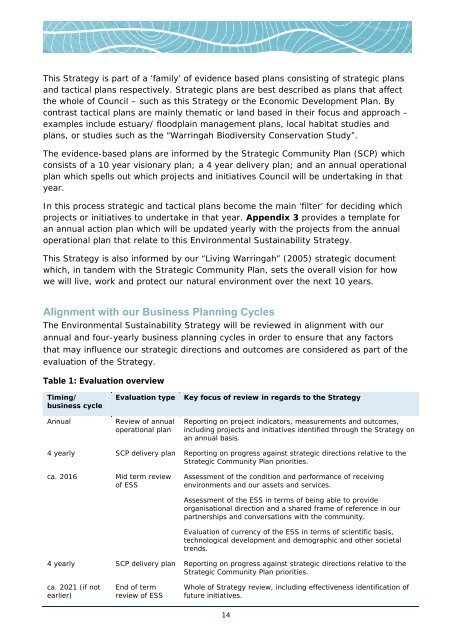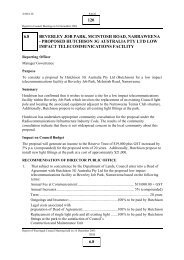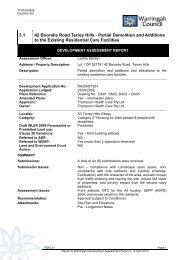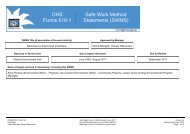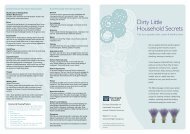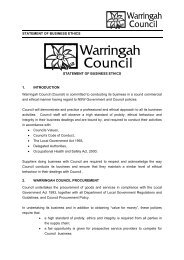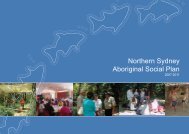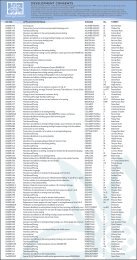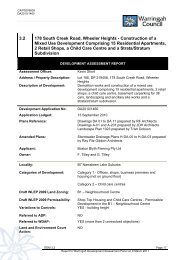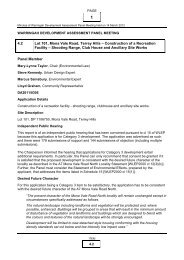Environmental Sustainability Strategy - Warringah Council - NSW ...
Environmental Sustainability Strategy - Warringah Council - NSW ...
Environmental Sustainability Strategy - Warringah Council - NSW ...
Create successful ePaper yourself
Turn your PDF publications into a flip-book with our unique Google optimized e-Paper software.
This <strong>Strategy</strong> is part of a ‘family’ of evidence based plans consisting of strategic plans<br />
and tactical plans respectively. Strategic plans are best described as plans that affect<br />
the whole of <strong>Council</strong> – such as this <strong>Strategy</strong> or the Economic Development Plan. By<br />
contrast tactical plans are mainly thematic or land based in their focus and approach –<br />
examples include estuary/ floodplain management plans, local habitat studies and<br />
plans, or studies such as the “<strong>Warringah</strong> Biodiversity Conservation Study”.<br />
The evidence-based plans are informed by the Strategic Community Plan (SCP) which<br />
consists of a 10 year visionary plan; a 4 year delivery plan; and an annual operational<br />
plan which spells out which projects and initiatives <strong>Council</strong> will be undertaking in that<br />
year.<br />
In this process strategic and tactical plans become the main ‘filter’ for deciding which<br />
projects or initiatives to undertake in that year. Appendix 3 provides a template for<br />
an annual action plan which will be updated yearly with the projects from the annual<br />
operational plan that relate to this <strong>Environmental</strong> <strong>Sustainability</strong> <strong>Strategy</strong>.<br />
This <strong>Strategy</strong> is also informed by our “Living <strong>Warringah</strong>” (2005) strategic document<br />
which, in tandem with the Strategic Community Plan, sets the overall vision for how<br />
we will live, work and protect our natural environment over the next 10 years.<br />
Alignment with our Business Planning Cycles<br />
The <strong>Environmental</strong> <strong>Sustainability</strong> <strong>Strategy</strong> will be reviewed in alignment with our<br />
annual and four-yearly business planning cycles in order to ensure that any factors<br />
that may influence our strategic directions and outcomes are considered as part of the<br />
evaluation of the <strong>Strategy</strong>.<br />
Table 1: Evaluation overview<br />
Timing/<br />
business cycle<br />
Annual<br />
Evaluation type<br />
Review of annual<br />
operational plan<br />
Key focus of review in regards to the <strong>Strategy</strong><br />
Reporting on project indicators, measurements and outcomes,<br />
including projects and initiatives identified through the <strong>Strategy</strong> on<br />
an annual basis.<br />
4 yearly SCP delivery plan Reporting on progress against strategic directions relative to the<br />
Strategic Community Plan priorities.<br />
ca. 2016<br />
Mid term review<br />
of ESS<br />
Assessment of the condition and performance of receiving<br />
environments and our assets and services.<br />
Assessment of the ESS in terms of being able to provide<br />
organisational direction and a shared frame of reference in our<br />
partnerships and conversations with the community.<br />
Evaluation of currency of the ESS in terms of scientific basis,<br />
technological development and demographic and other societal<br />
trends.<br />
4 yearly SCP delivery plan Reporting on progress against strategic directions relative to the<br />
Strategic Community Plan priorities.<br />
ca. 2021 (if not<br />
earlier)<br />
End of term<br />
review of ESS<br />
Whole of <strong>Strategy</strong> review, including effectiveness identification of<br />
future initiatives.<br />
14


